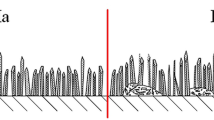Abstract
Kern-Seaton fouling model of enhanced tubes and two parameters that foulant sticking probability (P) and deposit bond strength factor (ξ) in that model are analyzed theoretically. A new modeling method of fouling in enhanced tubes is proposed, which has physical meaning and a higher accuracy in comparison to traditional ones. A semi-theoretical model of fouling in internal helical-rib tubes is developed in this paper based on the long-term fouling data, targeting to improve previous fouling models. This new fouling model has three variables: area index, j-factor ratio and friction factor ratio. This triple-variable model has a maximum deviation of 5.20% and an average deviation of 1.87%, indicating a higher accuracy than previous ones. The mathematical type of this new model is in accordance with the theoretic deduction, thus makes sense in theory compared with old ones. It is also found that all current fouling models without the correction of heat transfer area index (β) have the biggest deviation when predicting the fouling resistance of enhanced tubes with p/e around 3.5, but which can be reduced by introducing the area index into the model. The new modeling method presented in this paper has outstanding advantages in modeling fouling of enhanced tubes, thus can be used in future fouling research.
Similar content being viewed by others
References
ASHRAE, 1677-TRP, Measurement and prediction of waterside fouling performance of internally enhanced condenser tubes used in cooling tower applications, 2012.
Webb R.L., Chamra L.M., On-line cleaning of particulate fouling in enhanced tubes. Fouling and Enhancement Interactions, Minneapolis, 1991, 164: 47–54.
Abedin M.Z., Kim, N.H., An experimental study on accelerated fouling of aluminum oxide and ferric oxide particles in internally enhanced tubes. Journal of Mechanical Science and Technology, 2016, 30(12): 5707–5714.
Kim N.H., Particulate fouling and on-line cleaning of ferric oxide particles in internally enhanced tubes. Heat Transfer Engineering, 2018, 1(39): 40–50.
Somerscales E.F.C., Ponteduro A.F., Bergles A.E., Particulate fouling of heat transfer tubes enhanced on their inner surface. Fouling and Enhancement Interactions, Minneapolis, 1991, 164: 17–26.
Chamra L.M., Webb R.L., Effect of particle size and size distribution on particulate fouling in enhanced tubes. Journal of Enhanced Heat Transfer, 1993, 1(1): 65–75.
Webb R. L., Single-phase heat transfer, friction, and fouling characteristics of three-dimensional cone roughness in tube flow. International Journal of Heat and Mass Transfer, 2009, 52(11): 2624–2631.
Chamra L.M., Webb R.L., Modeling liquid-side particulate fouling in enhanced tubes. International Journal of Heat and Mass Transfer, 1994, 37(4): 571–579.
Webb R.L., Narayanamurthy R., Thors P., Heat transfer and friction characteristics of internal helical-rib roughness. Journal of Heat Transfer, 2000, 122 (1): 134–142.
Webb R.L., Li W., Fouling in enhanced tubes using cooling tower water: Part I: long-term fouling data. International Journal of Heat Mass Transfer, 2000, 43(19): 3567–3578.
Li W., Webb R.L., Fouling characteristics of internal helical-rib roughness tubes using low-velocity cooling tower water. International Journal of Heat and Mass Transfer, 2002, 45(8): 1685–1691.
Li W., The Internal surface area basis, a key issue of modeling fouling in enhanced heat transfer tubes. International Journal of Heat and Mass Transfer, 2003, 46(22): 4345–4349.
Wang Z., et al., Analysis of fouling characteristic in enhanced tubes using multiple heat and mass transfer analogies. Chinese Journal of Chemical Engineering, 2015, 23(11): 1881–1887.
Li W., Modeling liquid-side particulate fouling in internal helical-rib tubes. Chemical Engineering Science, 2007, 62(16): 4204–4213.
Li W., Li G., Modeling cooling tower fouling in helical-rib based on Von-Karman analogy. International Journal of Heat and Mass Transfer, 2010, 53(13–14): 2715–2721.
Shen C., Cirone C., Wang X., Uncertainty analysis: design of a fouling test device for the liquid-to-refrigerant heat exchangers. Applied Thermal Engineering, 2015, 85: 148–159.
Shen C., Wang L., Ford S.E., et al., A novel fouling measurement system: Part II. Commissioning. International Journal of Heat and Mass Transfer, 2017, 110: 950–961
Shen C., Wang L., Ford S.E., et al., A novel fouling measurement system: Part I. design evaluation and description. International Journal of Heat and Mass Transfer, 2017, 110: 940–949.
Shen C., Cirone C., Wang X., A method for developing the prediction model of water-side fouling on enhanced tubes. International Journal of Heat and Mass Transfer, 2015, 85: 336–342.
Shen C., Cirone C., Jacobi A.M., et al., Fouling of enhanced tubes for condensers used in cooling tower systems: a literature review. Applied Thermal Engineering, 2015, 79: 74–87.
Shen C., Cirone C., Yang L., et al., Characteristics of fouling development in shell-and-tube heat exchanger: Effect of velocity and relative location. International Journal of Heat and Mass Transfer, 2014, 77(4): 439–448.
Kern D.Q., Seaton R.A., A theoretical analysis of thermal surface fouling. British Chemical Engineering, 1959, 4(5): 258–262.
Li W., Webb R.L., Fouling in enhanced tubes using cooling tower water part II: combined particulate and precipitation fouling. International Journal of Heat and Mass Transfer, 2000, 43(19): 3579–3588.
Zhang W., Li G., Zhang Z., et al., Fouling model of internal helical-rib tubes based on prandtle analogy. Proceedings of the CSEE, 2008, 28(35): 66–70. (In Chinese)
Li W., Zhang W., Li G., et al., Experimental research on the fouling resistance of internal helical-rib tubes, Journal of Engineering Thermophysics, 2009, 30(9): 1578–1580.
Watkinson A.P., Epstein N., Particulate fouling of sensible heat exchangers. Proceeding of the 4th International Heat Transfer Conference, Paris, 1970, 1: 1–12.
Beal S.K., Particulate Fouling of Heat Exchangers, in “Fouling of Heat Exchanger Surface”, Ed., Bryers R.W., Engineering Foundation. New York, USA, 1983, pp. 215–234.
Acknowledgment
The authors gratefully acknowledge the funding support from the National Natural Science Foundation of China (Project#: 51606049). The authors also appreciate the technical input from Wieland Company.
Author information
Authors and Affiliations
Corresponding authors
Rights and permissions
About this article
Cite this article
Shen, C., Wang, Y., Gao, R. et al. An Improved Modeling Method of Water-side Fouling in Enhanced Tubes of Condensers in Application of Cooling Water Tower. J. Therm. Sci. 28, 30–39 (2019). https://doi.org/10.1007/s11630-018-1021-4
Received:
Published:
Issue Date:
DOI: https://doi.org/10.1007/s11630-018-1021-4




